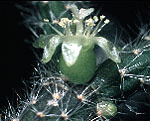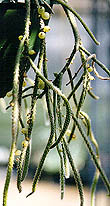Rhipsalis fasciculata (Willdenow) Haworth, Suppl.
Pl. Succ. 83. 1819.
Cactus fasciculatus Willdenow, Enum. P1. Suppl. 33. 1813.
Hariota fasciculata Kuntze, Rev. Gen. P1. 1: 262. 1891.
Reduced to synonymy under R. baccifera ssp. baccifera
by Barthlott and Taylor Bradleya 13
Information from Britton & Rose 1920
- Stems woody, terete, much branched;
- Branchlets clavate to cylindric, faintly ribbed when old, 4 mm. in diameter,
with numerous
- Areoles each with a cluster of fragile hairs 3 to 4 mm. long;
- Flowers lateral but not described;
- Ovary not sunken in the branch;
- Fruit globose, small, bearing a few areoles, these pubescent and
setose.
- Type locality: Not cited.
- Distribution: Brazil
.
We have studied Madagascan specimens of this plant sent from Kew and
one sent from Bahia, Brazil, to Dr. Rose by L. Zehntner in 1920. De
Candolle (Plantes Grasses 1: pl. 59) states that it occurred in Santo
Domingo. Roland-Gosselin says that it inhabits American Islands;
our very extensive explorations in the West Indies have failed to discover
it. The Brazilian plant differs only from the Madagascan by having fewer
hairs at the areoles.
In search of the type locality of Cactus fasciculata Willdenow
1813 by Derek Butcher in 2001
The first reference I have is: De Candolle in Prodromus Systematis
Naturalis Regni Vegetabilis 3 : 475-476. 1828 (page 476).
2. R. FASCICULATA (Haw. ex Steud. nom.) pendula, ramis teretibus fasciculatis,
pilis
cum fasciculis ordine quincunciali spiraliter servatis secùs
ramos juniores. ? in ins.
Caribaeis. Cactus parasiticus Lam. dict. I. p. 541. DC. pl. grass. t.
59. C. fasciculatus
Willd. enum. suppl. 33. Rhipsalis parasiticus Haw. syn. 187. (v. v.)
English translation
Plant pendulous, branches tubular and clustered, with hair clustered
in 5/12 spirals preserved along the younger branches. Found in the Caribbean
Islands. Then we refer to Torreya August 1909 where N L Britton discusses
“Rhipsalis in the West Indies”. I was rather amused by his
comment “ Through Linnaeus’s blunder of uniting two widely
different plants, which he only knew from illustrations, we are apparently
prevented from using the name Hariota, and the next available
generic name is Rhipsalis.”
I think we will agree that “blunders” continue to this day
and some can be attributed to N L Britton!
Rhipsalis cassutha is found on these Islands because Britton
cites plants collected on various islands. I quote his comments., “The
young shoots are often quite bristly, but the mature plant becomes smooth;
flowers are sometimes developed before the bristles fall away. In the
West Indies the plant has not been observed by me at a greater altitude
than about 500 meters” His interpretation of R. cassutha was
as follows.
1. Rhipsalis Cassutha Gaertn. Fr. & Sem. I: 137. 1788
Cassytha filiformis Mill. Gard. Dict. Ed. 8. 1768. Not L.
Cactus parasiticus Lam. Encycl. I: 541. 1783. Not L.
Cactus pendulus Sw. Fl. Ind. Occ. 2: 876. 1800.
Cactus caripensis H.B.K. Nov. Gen. 6; 66. 1823.
Cereus caripensis DC. Prodr. 3: 467. 1828.
Rhipsalis parasiticus DC. Prodr. 3: 476. 1828.
Cactus fasciculatus Willd. Enum. Suppl. 33. 1813.
Rhipsalis parasitica Haw. Syn. Pl. Succ. 187. 1812.
Rhipsalis fasciculata Haw. Suppl. 83. 1819.
Rhipsalis cassythoides G. Don, Gen. Syst. 3 : 176. 1834
Rhipsalis dichotoma G. Don, Gen. Syst. 3: 176. 1834
Rhipsalis undulata Pfeiff. Enum. 156. 1837.
Rhipsalis Hookeriana G. Don, Gen. Syst. 3: 176. 1834
Hariota parasitica Kuntze, Rev. Gen. Pl. 262. 1891.
Plant often 1 m. long or longer, much branched, light green, pendent
from trees or on cliffs, the branches flexible; flowers 6-8 mm. long;
petals about 4, ovate, obtuse; stamens about 9.
TYPE LOCALITY: Not cited.
To my mind this meant that he could not discern any differences between
these synonyms and treated them all as R. cassutha whether
they came from “San Luis Potosi, Mexico, to Costa Rica, Colombia,
Bolivia, Venezuela, and Brazil, Tropical Africa, Mauritius, Ceylon”.
None of the Journals quoted gives a lead as to the type locality for
these synonyms except that for Cactus pendulus which must have come
from the West Indies!
Let us now move on to Torreya July 1913 where we read a paper by R.
Roland-Gosselin which had been translated into English by E G Britton.
On page 151 we read “Commerson found on the island of Mauritius
R. mauritiana and R. fasciculata”
Question. What did Commerson see in the differences between R. mauritiana
and R. fasciculata? Commerson’s find seems to been ignored
by later writers.
On page 152 we read “Weber……considers his R. madagascarensis
as a synonym of the old R. fasciculata Haw. indicated
by P. De Candolle and Lamarck as originating in Santo Domingo and adjacent
islands”
On page 153 we read “The existence on the American Continent of
Rhipsalis fasciculata Haw. has not been proven, and it is remarkably
curious that it has not been found except on the Islands of America
and Africa, near the sea in the latter part of the World.” Perhaps
he should have said “including Mauritius and Madagascar”!
Now to Britton & Rose where information is given above.
We know that N L Britton (see Paper in 1909) collected in the West Indies
but at that time could not tell the difference between R. fasciculata
and R. cassutha because R. fasciculata is listed as a synonym
of R. cassutha! So how did he know that R. fasciculata was
NOT in the West Indies? No mention is made as to the reason for his
change of mind or why a plant found in Bahia suddenly acquired the name
R. fasciculata!
It would seem that R. fasciculata has been “seen”
in the West Indies, Bahia, Madagascar, and Mauritius whereas its likely
home seems to be the West Indies. I think it better to leave this ill-documented
species hidden under R. baccifera ssp. baccifera.
R fasciculata (cluster-branched); Bot. Mag.
3079.
Detail from Cactus Culture – Watson 1889
-Stems terete, as thick as a goose-quill. Branches usually in clusters,
and sometimes jointed, green, with small red dots and little tufts of
fine, hair-like bristles. Flowers white, produced in March, springing
irregularly from the older branches, small, star-like. Fruit a white
berry. From its habit of growing on trees, and the character of its
stems and fruit, this plant has been called parasitical. It is, however,
only indebted to the tree on which it grows for moisture, for it thrives
if planted in a pot or basket in ordinary soil, and kept in a stove
temperature. It is a native of Brazil, and was introduced in 1831.
 
Photo on right
from Huntington Botanical Gardens 9/99 (KAF).
Previous Page
|
|

